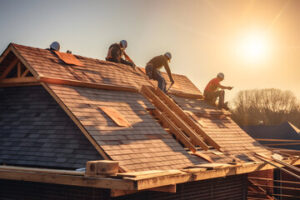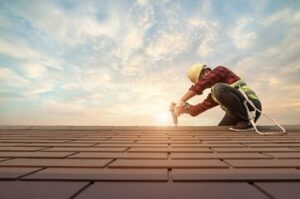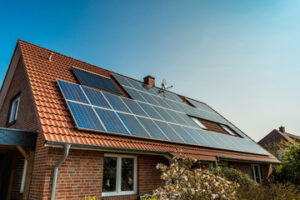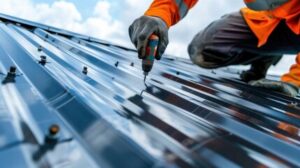Gutter Cleaning St Louis is an important home maintenance task that can prevent damage to the roof and foundation of a house. Gutter Cleaning also helps prevent pest infestation, including mosquitoes, ants, rodents, and termites.
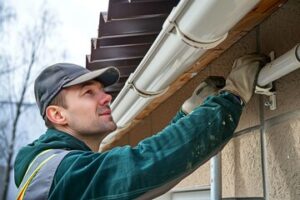
Professional gutter cleaners use a combination of ladders and high-powered blowers to unleash a controlled burst of air that dislodges leaves, twigs, and built-up sediment from the clogged gutters.
When it comes to gutter cleaning, the right tools are a must. Rolling up your sleeves and scrubbing by hand is one way to tackle the job, but it’s messy, labor-intensive, and can be dangerous if you’re not careful. Fortunately, there are a number of high-powered blowers designed specifically for this task that can make the work much easier and safer.
One popular option is to use a garden hose with an attachable gutter nozzle that redirects the blower’s airflow into the gutter, effectively blasting away gunk and debris. This handy tool is a good choice for moderately clogged gutters, and it keeps you on the ground instead of on a ladder, which helps minimize the risk of falling debris or ladder-related accidents.
Another option is a gutter flusher, which uses a high-powered jet stream of water to blast away dirt and debris from the exterior surfaces of the gutters and downspouts. This is a great alternative to traditional gutter scrubbing and can save you a lot of time and effort. These tools are typically available with extendable metal poles that enable you to reach hard-to-reach areas without the need for a ladder.
A third method involves a gutter cleaning scoop, which is similar to a garden trowel but with a curved tip that allows you to scrape out gunk from the corners of the gutters. This is another effective option for moderately clogged gutters, but it can be messy and requires that you wear goggles to protect your eyes from flying debris.
For a truly low-tech approach, you can also try using an ordinary leaf blower with an extension kit that adds a curved, gutter-oriented nozzle. This makes it easy to clean your gutters from the ground, and it’s a good idea to wear goggles when doing this to protect your eyes and ears. You can also purchase specialized gutter cleaning attachments for your existing backpack blowers, which are ideal for unclogging clogs and directing the airflow precisely where it’s needed. For a really high-tech solution, there are even robotic gutter cleaners that can handle the job on their own, saving you from the need for manual labor and risky ladder climbs.
Safety First
Gutter cleaning involves climbing ladders and working at heights, which can present safety risks. However, these risks can be minimized with a little preparation. By clearing the area around gutters and marking any areas that require special attention, homeowners can facilitate the gutter cleaning process and ensure a safer experience.
Clogged gutters can lead to water overflow and damage your roof, siding, foundation, and other parts of your home. It can also create a perfect environment for mold and mildew to grow, which poses health issues and damages building materials. Regular gutter cleaning prevents clogs and overflow, protecting your house from costly repairs.
As an added bonus, regular cleaning and maintenance can improve your home’s curb appeal, making it more attractive to potential buyers. It can also help protect your landscaping from damage caused by rainwater overflowing the gutters. Gutter cleaning and maintenance are a great way to save money on expensive gutter repair and restoration.
Gutter cleaners can be rented or purchased at most hardware and home improvement stores. Some are designed to be used on a hose while others are made for manual use. They are available in a range of sizes and shapes, and some include attachments for cleaning roof valleys or behind chimneys. Choosing the right tool for the job can make the difference between an easy and efficient gutter cleaning or a frustrating one.
It’s essential to wear sturdy shoes and protective eye gear when cleaning gutters. Gloves are important to protect your hands from bacteria-ridden debris – especially rotting leaves and bird, pigeon, or squirrel feces. It’s best to work with someone else if possible, as it’s important to have two points of contact on the ladder at all times – one foot and the other hand gripping the ladder.
Begin by visually inspecting the gutters for any cracks, holes, or signs of rust or rot that need to be addressed. It’s also a good idea to check downspouts for blockages, as they are the primary route of water flow away from your home. If you find any clogs, start by using a garden hose to flush out the gutters and remove any debris.
Preparation Is Key
While gutter cleaning may seem like a minor component of home maintenance, it’s one that plays a critical role in safeguarding your property from costly water damage. Clogged gutters block rainwater, causing it to overflow onto the roof or down the sides of your house. Over time, this can cause serious structural damage. In addition, clogged gutters create the ideal habitat for pests and rodents, who thrive on the rotting debris that builds up in them. Regular gutter cleaning eliminates these breeding grounds, thereby preventing infestations of pests that can carry deadly diseases.
Gutter cleaning also helps to ensure that your landscaping flourishes. Without clean gutters, overflowing rainwater can wash away soil and wash out seedlings you’ve painstakingly planted. It can also injure or kill trees and shrubs that you’ve invested so much time and effort into, threatening the value of your home. Moreover, a clogged gutter can inflict unsightly damage on the foundation of your house.
As such, it’s important to prepare for gutter cleaning before your service technicians arrive. This can include ensuring that any vehicles or garden furniture are moved to clear the pathway to your house, as well as removing any obstacles or objects that could get in their way while they’re maneuvering their ladders and tools. Ideally, it’s also best to lay down tarps or sheets beneath the work area. This will help to catch any debris that is washed away or falls during the process and make disposal post-service easier.
The final step in preparation is to have the right equipment ready for the job. A sturdy ladder with solid steps and a firm base is essential, as are shoes or boots with non-slip soles. Additionally, a plastic gutter scoop is a great tool for this task and can be purchased at most hardware stores. Lastly, a garden hose with a pistol-grip trigger spray nozzle is ideal for hosing down your gutters and rinsing off any accumulated dirt. This is also a good opportunity to do a thorough inspection of your gutters and downspouts to identify any visible signs of damage or wear and tear.
Efficiency
Gutter cleaning isn’t just a tedious household chore, but it also helps protect the home from costly problems. Dirty gutters clog the downspouts and impede the flow of rainwater, which can lead to basement flooding and foundation damage, as well as promote the growth of mildew and mold that can affect the health and comfort of residents.
Regular gutter cleaning is the best preventative measure against these serious issues. When this task is neglected, it can be a recipe for disaster: clogged gutters create an unintentional dam that can cause water to flood the roof and seep through the walls of the house, destroying furniture, electronics, and other valuables. In addition, a dirty gutter system is an inviting nesting and breeding place for pests like rats, birds, mosquitoes, and other insects that can spread deadly diseases.
Aside from these serious problems, a clogged gutter inhibits proper roof ventilation and increases the risk of thermal expansion and contraction of roofing materials. The result is that more heat gets trapped in the attic during summer, requiring homeowners to rely more on air conditioning, which in turn leads to higher energy consumption and bills. Gutter cleaning services help address this problem by removing all debris from the gutter system and maintaining a clear channel for water to drain through.
Lastly, a clean gutter system allows the free flow of rainwater and ice, which is crucial for protecting the roof from ice dams. A clogged gutter can trap ice that puts additional weight on the shingles, and it can also shift them over time, causing them to fall off. Regular gutter cleaning minimizes these risks and prolongs the lifespan of the roof.
Gutter cleaning requires the use of a ladder, which can be dangerous for those without the right training or experience. By following a few simple safety tips, such as working on level ground and keeping the body between the ladder side rails, you can safely complete this important maintenance job. However, if you’re not comfortable with working on ladders, it’s always a good idea to leave the job to a professional gutter cleaning company.

